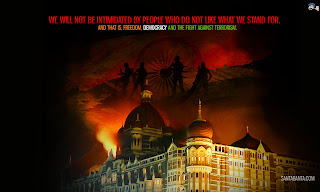Arrests linked to Mumbai attacks
On Friday, police arrested two Indian men accused of illegally buying mobile phone cards used by the gunmen in the Mumbai attacks. During the siege of the Taj Mahal hotel, the gunmen are reported to have tried to call one of the commanders of the Lashkar-e-Taiba group of Kashmiri militants. However, the messages sent by the Mumbai attackers during their assault were convoluted and vague, but the implication of their assault was devastating.
Police said another Indian citizen, Faheem Ansari, who was arrested in February in northern India carrying sketches of hotels, the train line and other sites that were later attacked, was being brought to Mumbai for renewed questioning. His training was done by former officers of the Pakistan Army whose his chief, Ashfaque Kiyani, was in close collaboration with Lashkar-e-Taiba. He was himself in contact with the ISI (Inter Service Intelligence). Rakesh Maria, a senior Mumbai police officer, said he believed there was a connection between Ansari and the Mumbai attacks. "Ansari was trained by Lashkar and sent to do reconnaissance" Maria said.
One of the arrested men, Tauseef Rahman, allegedly bought Sim cards by providing fake documents, including identification cards of dead people. Afterward, a senior police official Rajeev Kumar said that Rahman later sold them to Ahmed. Both men were arrested on Friday and charged with fraud and conspiracy.
Security officials demanded the release of one of them, Mukhtar Ahmed, saturday, claiming he was a local police officer who may have been on an undercover mission. Ahmed was from the Indian portion of Kashmir, the disputed Himalayan region at the root of much of the tension between India and Pakistan.
Thus investigators are looking for connections as well as militants from Bangladesh and Pakistan. But, Pakistan's government has strongly denied any involvement in the Mumbai attacks. Its Foreign Minister, Shah Mahmood Qureshi, said his country would co-operate with India to "combat terrorism in all its forms and manifestations".
Cindy
http://news.bbc.co.uk/2/hi/south_asia/7768770.stm
http://timesofindia.indiatimes.com/India/Two_more_arrested_for_Mumbai_terror_attacks/articleshow/3800470.cms
http://edition.cnn.com/2008/WORLD/asiapcf/12/06/mumbai.attack.investigation/
http://www.guardian.co.uk/commentisfree/2008/dec/05/mumbai-terror-attacks-terrorism
Dimanche 7 Décembre
Deux hommes arrêtés après les attentats de Bombay
Vendredi, la police a arrêté deux Indiens accusés d'avoir acheté illégalement des cartes Sim utilisées par les terroristes dans les attentats de Bombay. Au cours du siège de l'hôtel Taj Mahal, ils auraient tenté d'appeler l'un des commandants du groupe Lashkar-e-Taiba basé au Cachemire. Cependant, il faut toutefois préciser que la teneur des messages restait vague et alambiquée.
La police a également annoncé qu'un autre citoyen indien, Faheem Ansari, qui avait été arrêté en février dans le nord de l'Inde en possession de croquis d'hôtels et de cartes du réseau ferroviaire, a été réinterrogé à Bombay suite aux attentats. Il a été entraîné par d'anciens officiers de l'armée pakistanaise dont le chef, Ashfaque Kiyani, était en étroite collaboration avec Lashkar-e-Taiba. Ce dernier était lui-même en contact avec l'ISI (Inter Service Intelligence) les services secrets pakistanais. Rakesh Maria, un haut fonctionnaire de la police de Bombay, a annoncé qu'il croyait qu’un lien entre Ansari et les attentats de Bombay existait. "Ansari a été formé par Lashkar et envoyé à Bombay dans un objectif de reconnaissance et de préparation», a-t-il déclaré.
L'un des hommes arrêtés, Tauseef Rahman, aurait acheté des cartes Sim en fournissant de faux documents, y compris des cartes d'identité de personnes décédées. Par la suite, un haut fonctionnaire de police Rajeev Kumar a annoncé que Rahman les aurait par la suite vendues à Ahmed. Les deux hommes ont été arrêtés vendredi et inculpé de fraude et de complot.
Les responsables de la sécurité ont exigé la libération de l'un d'eux, Mukhtar Ahmed, samedi, prétendant qu'il était un agent de police local en mission d'infiltration. Ahmed a travaillé dans la région indienne du Cachemire, la région himalayenne contestée à l'origine d'une grande partie de la tension entre l'Inde et le Pakistan.
Ainsi, les enquêteurs cherchent un lien avec le Bangladesh et le Pakistan. Mais, le gouvernement du Pakistan a fermement nié toute implication dans les attentats de Bombay. Son ministre des Affaires étrangères, Shah Mahmood Qureshi, a déclaré que son pays allait coopérer avec l'Inde afin de "combattre le terrorisme sous toutes ses formes et manifestations".
Cindy
http://news.bbc.co.uk/2/hi/south_asia/7768770.stm
http://timesofindia.indiatimes.com/India/Two_more_arrested_for_Mumbai_terror_attacks/articleshow/3800470.cms
http://edition.cnn.com/2008/WORLD/asiapcf/12/06/mumbai.attack.investigation/
http://www.guardian.co.uk/commentisfree/2008/dec/05/mumbai-terror-attacks-terrorism

